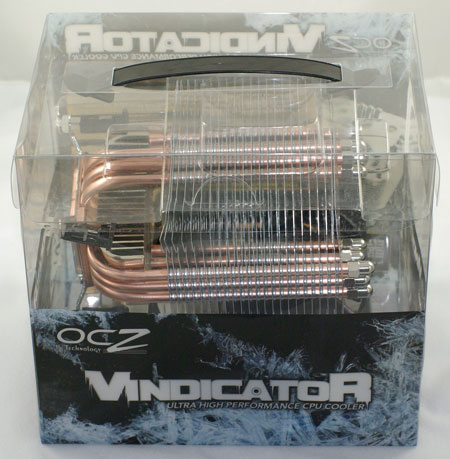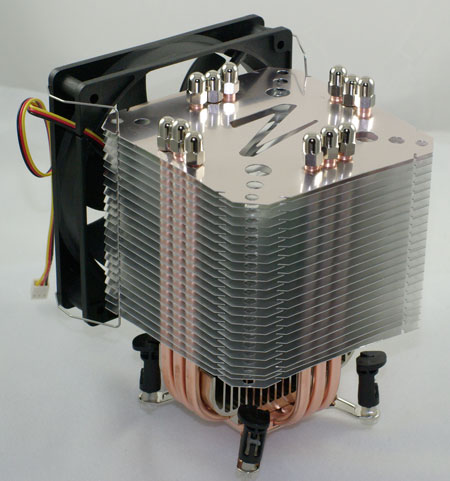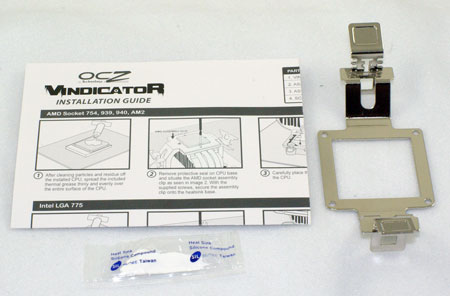OCZ Vindicator: Heatpipe Tower Cooling from OCZ
by Wesley Fink on April 5, 2007 4:00 AM EST- Posted in
- Cases/Cooling/PSUs
OCZ Vindicator
The Vindicator is packaged is a slick acrylic box. This certainly allows the package to stand out on shelves, since you can see everything about the cooler through the clear shell.

While the packaging makes the Vindicator stand out, we do have some questions about how well it protects the heatpipe tower from damage during shipment. The cooler we received looked great in the package and the package seemed sturdy enough, but the shipping process had caused a lot of crushed fins opposite the visible side of the package. They were straightened with a knife and some patience, but not all buyers will want to straighten fins on a new cooler. A sturdier package would help.

The Vindicator cooler is a bit different in configuration from most other heatpipe coolers. While it uses 6 u-shaped heatpipes to cool they are arranged as 3-pipe arrays at a ninety degree angle. This places three heatpipe rods on each side. Unlike the Scythe Infinity or Thermalright Ultra 120, which are wider than they are flat, the Vindicator design makes a square cooler which is much deeper than most of the other heatpipe coolers. This is the same configuration used in the Scythe Ninja Rev. B.

As already mentioned the Socket 775 adapter is installed, but the AM2/939/940/754 adapter is also included along with a small packet of thermal compound and installation instructions. You are not required to remove the motherboard to mount the Vindicator. It uses standard Intel-type push pins for mounting on Socket 775. However, space is very limited above the mounting area so you will likely want to mount the Vindicator before installing a fan.
The Vindicator is a big cooler and it takes up a lot of space in the case. While a simple installation is always preferred, the weight that is being supported by those four pop-in clips is a real concern. With no back plate this is not a cooler you will want to use in a system you move around. The motherboard could easily be overstressed and fail or it could actually break the board with rough handling.
Specifications
The Vindicator will mount on all current CPU sockets, but it does not support the older Intel Socket 478. If you have a Socket 478 CPU you will need to buy the Scythe Ninja Rev. B instead.
The fan included with the Vindicator is clearly aimed at the silent cooler market. The airflow is relatively low and noise is rated at just 18.5 DBA. However, the fan mount will handle any 120mm fan, so you can choose from a wide variety of popular 120mm fans if the stock fan does not deliver what you are looking for.
The Vindicator also allows mounting of multiple fans if you choose, as we demonstrated in the Scythe Infinity review. The aluminum cooling fins have a pair of grooves on each side to provide flexibility in fan mounting. Using extra wires and careful positioning you should be able to mount as many as 4 fans for cooling on the Vindicator.
The Vindicator is packaged is a slick acrylic box. This certainly allows the package to stand out on shelves, since you can see everything about the cooler through the clear shell.

While the packaging makes the Vindicator stand out, we do have some questions about how well it protects the heatpipe tower from damage during shipment. The cooler we received looked great in the package and the package seemed sturdy enough, but the shipping process had caused a lot of crushed fins opposite the visible side of the package. They were straightened with a knife and some patience, but not all buyers will want to straighten fins on a new cooler. A sturdier package would help.

The Vindicator cooler is a bit different in configuration from most other heatpipe coolers. While it uses 6 u-shaped heatpipes to cool they are arranged as 3-pipe arrays at a ninety degree angle. This places three heatpipe rods on each side. Unlike the Scythe Infinity or Thermalright Ultra 120, which are wider than they are flat, the Vindicator design makes a square cooler which is much deeper than most of the other heatpipe coolers. This is the same configuration used in the Scythe Ninja Rev. B.

As already mentioned the Socket 775 adapter is installed, but the AM2/939/940/754 adapter is also included along with a small packet of thermal compound and installation instructions. You are not required to remove the motherboard to mount the Vindicator. It uses standard Intel-type push pins for mounting on Socket 775. However, space is very limited above the mounting area so you will likely want to mount the Vindicator before installing a fan.
The Vindicator is a big cooler and it takes up a lot of space in the case. While a simple installation is always preferred, the weight that is being supported by those four pop-in clips is a real concern. With no back plate this is not a cooler you will want to use in a system you move around. The motherboard could easily be overstressed and fail or it could actually break the board with rough handling.
Specifications
The Vindicator will mount on all current CPU sockets, but it does not support the older Intel Socket 478. If you have a Socket 478 CPU you will need to buy the Scythe Ninja Rev. B instead.
| OCZ Vindicator Specifications | |
| Heatsink | |
| Dimensions | 110(L) X 110(W) X 150(H)mm (excluding fan) |
| Weight | 640g (excluding fan) |
| Material | Copper and Aluminum |
| Fan Configuration | Supports 120mm fans (120mm fan included) Open or closed mounting posts. |
| Included Fan | |
| Fan Size | 120mm x 120mm x 25mm |
| Bearing Type | Sleeve Bearing |
| Noise Level | 18.5 dB-A |
| Speed | 1000 RPM |
| Air Flow | 40 CFM |
| Static Pressure | 1.40mm H2O |
| Weight | 130g (fan only) |
The fan included with the Vindicator is clearly aimed at the silent cooler market. The airflow is relatively low and noise is rated at just 18.5 DBA. However, the fan mount will handle any 120mm fan, so you can choose from a wide variety of popular 120mm fans if the stock fan does not deliver what you are looking for.
The Vindicator also allows mounting of multiple fans if you choose, as we demonstrated in the Scythe Infinity review. The aluminum cooling fins have a pair of grooves on each side to provide flexibility in fan mounting. Using extra wires and careful positioning you should be able to mount as many as 4 fans for cooling on the Vindicator.










41 Comments
View All Comments
Wesley Fink - Thursday, April 5, 2007 - link
For those that have complained that our 36db ambient room noise is very high I am posting info from SilentPCReview's article "Noise in COmputing: A Primer" at http://www.silentpcreview.com/article121-page1.htm...">http://www.silentpcreview.com/article121-page1.htm....SPL (dB) TYPICAL ENVIRONMENT AVERAGE DESCRIPTION
140 30 meters from military aircraft at take off Threshold of pain
120 Boiler shop (maximum levels)
Ships engine room (full speed) Almost intolerable
100 Automatic lathe shop
Platform of underground station (maximum levels)
Printing press room Extremely noisy
80 Curbside of busy street
Office with tabulating machines Very noisy
60 Restaurant, Department Store; Noisiest Gamer PC Noisy
50 Conversational speech at 1 meter; Noisy workstation Clearly audible
35 - 45 Quiet office or library; Typical PC Subdued
25 - 30 Bedroom at night, Quiet PC Quiet
20 - 25 Quiet whisper; Very quiet PC
Background in TV and recording studios Very quiet
15 - 20 Super quiet / fanless PC Barely audible
<15 Sounds of internal organs Normally inaudible
0 'Normal' threshold of hearing Not audible
As you can see 35 to 45db is considered a Quiet Office or Library or the noise level of a Typical PC Subdued. At 36db I am at the low end of that noise category. When you discuss noise it is useful to keep these comparisons in mind.
In the revamping of our test bed we will be aiming to drop into the next category if possible using realistic means in our test romm and test platform. We have stated in our reviews that we measure noise at a constant distance above the open side of a system mounted in a PC Case. As we have also said this means you should consider our noise measurements the worst case you will see for the component tested. A closed case reduces noise and greater distance from the component reduces noise. Any measurements that fall below our system noise floor are reported as the noise floor measurement.
bob4432 - Thursday, April 5, 2007 - link
i would say my bedroom at night is more around 80-100db :)yacoub - Thursday, April 5, 2007 - link
So basically this thing cools nowhere near as effectively as an Ultra 120 (judging by your charts that show it a good 10 degrees Celcius hotter than the Ultra 120 at given points.Also, what would really make these hsf reviews even more helpful would be to see a nice list fitments on popular boards (a couple 680i, 650i, P965, and 975 boards you have around the labs). Give it a green, yellow, or red for fitment - Green, it fits fine and mounts easily. Yellow, it will fit but requires some frustration and/or 'editing' of the hardware (i.e. adding shims, shaving with a dremmel or similar), and Red, it simply will not fit... caps in the way or similar issues.
Wesley Fink - Thursday, April 5, 2007 - link
As we said in Final Words " . . . but cooling is not in the same league as the top Tuniq and Thermalright coolers we have evaluated at AnandTech."The OCZ Vindicator is competetive with the better coolers when you add a higher output fan, but the cooling performance is still far below the Tuniq Tower 120 and the Thermalright Ultra 120/Ultra 120 Extreme.
yacoub - Thursday, April 5, 2007 - link
Please don't miss the important part of my comment, which was not the first sentence stating the obvious, but the larger portion in bold. Thanks.Wesley Fink - Thursday, April 5, 2007 - link
I didn't miss your bold. Adding fitment info is a good suggestion.poohbear - Thursday, April 5, 2007 - link
dude, anandtech or any private site should NOT be responsible for testing product compatibility for a company, that's the company's responsibility.did you get my message in bold? good. unless OCZ is gonna pay sites to do this, then anantech shouldnt be doing OCZ's job for them.
DrMrLordX - Thursday, April 5, 2007 - link
Who got the silentpcreview forum posters all in a tiff? The article wasn't *that* bad. It should be obvious by now that cooling performance and overclocking performance are the two main foci of these articles.As anyone who reads Anandtech regularly should know, Anandtech reviewers doing "sideshow" reviews with limited testing equipment/materials include whatever happens to be handy in lieu of using an extensive array of parts. Someone sent them the SilenX fan, so they used it. Big whoop.
Pay attention to the cfm ratings and ignore the commentary on noise if you're so upset about it.
Overall, I found the review to be "eh" because they reviewed a less-than-exciting hsf. It performed poorly without an add-on fan, and with an add-on fan, it was still beaten soundly by top-tier coolers using included fans (some with lower cfm ratings). I guess I have to ask, "why bother?".
I'm not even entirely sure why they included the SilenX fan other than to discover if the HSF had some kind of potential to be a great balance of silence and performance, but I think we can all agree that the dual low-cfm Infinity holds that distinction.
It IS good to know that a fan comparison is coming up. I guess that may be one reason why the SilenX fan made it into this review . . . we should expect to see it later in the fan review.
Chunga29 - Thursday, April 5, 2007 - link
My thoughts exactly, for the most part. SPCR has its own niche and this is not the same market. So the noise level is higher than anyone at SPCR would allow? Big deal. I also don't recall reading anything where they stated that the specs of the fan, HSF, etc. were 100% truthful. They just used a fan that almost certainly had a noticeably higher air movement potential, and the testing bears this fact out. For a real-world test case (which SPCR doesn't do) the SilenX was no louder than the original fan and improved cooling. That's somewhat useful information.Actually now that I think about it, I know exaclty why the SPCR guys are pissed. It's the paragraph on page 7:
Looks like someone ruffled the feathers of the "more knowledgeable than thou" silent PC people. You read their testing and it really is quite silly at times. They basically test each part in near total isolation. I can attest to the fact that a "quiet" fan sitting in the open and suspended on foam is not nearly as loud as the same fan in a case. I'm a bit curious as to why the HSF testing environment is so loud, relatively speaking (only 36.4 dB minimum with everything off!?), but at least the results are consistent.
Spoelie - Thursday, April 5, 2007 - link
You're actually using flawed logic there. How much of the time is your cpu under heavy load? How much of the time has your psu kicked up the pace? The idle and mid load levels are a lot more active and make up the majority of the time of almost any desktop computer. Consider the following for a real world scenario...The corsair and seasonic do not kick up their fans till they provide about 250-300w. This load level will only be achieved when both the vidcard and cpu are under load, a cpu alone will not reach that load level. Now the only case in which both the heavy consumers are under load is gaming, at which point we do not really care about noise levels anymore, since the gaming sound effects will drown out any noisy fan.
However, if we're working in windows, either lightly loaded (browsing, ...) or heavily loaded (encoding a something to h.264, ...) we're much more easily irritated by a noisy computer. The good thing about the other psu's is that in those scenarios, they will be at their base noise floor, and virtually silent, certainly quieter than the OCZ. So at that point we can objectively measure the difference between the fan configurations.
So in essence, PURELY REGARDING NOISE LEVELS, spcr has a more realistic sound measuring system. I do know however that this is not the focus of this article, so it's kinda silly trying to defend the article on these points. Read the article for the overclocking and temperature levels, that's what it's good for.